

Bird. Modern birds are characterised by feathers, a beak with no teeth, the laying of hard-shelled eggs, a high metabolic rate, a four-chambered heart, and a lightweight but strong skeleton.
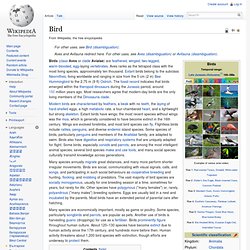
Extant birds have wings; the most recent species without wings was the moa, which is generally considered to have become extinct in the 16th century.
Thrush (bird) They are insectivorous, but most species also eat worms, land snails, and fruit.
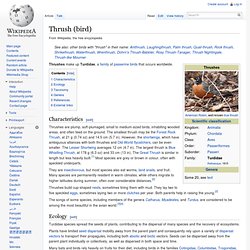
Many species are permanently resident in warm climates, while others migrate to higher latitudes during summer, often over considerable distances.[2] The songs of some species, including members of the genera Catharus, Myadestes, and Turdus, are considered to be among the most beautiful in the avian world.[3][4] Turdidae species spread the seeds of plants, contributing to the dispersal of many species and the recovery of ecosystems. Plants have limited seed dispersal mobility away from the parent plant and consequently rely upon a variety of dispersal vectors to transport their propagules, including both abiotic and biotic vectors.
Seeds can be dispersed away from the parent plant individually or collectively, as well as dispersed in both space and time. Hummingbird. Hummingbirds are New World birds that constitute the family Trochilidae.
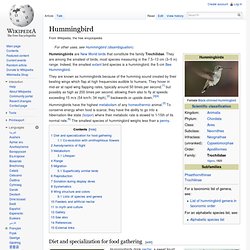
They are among the smallest of birds, most species measuring in the 7.5–13 cm (3–5 in) range. Indeed, the smallest extant bird species is a hummingbird, the 5-cm Bee Hummingbird. They are known as hummingbirds because of the humming sound created by their beating wings which flap at high frequencies audible to humans. They hover in mid-air at rapid wing flapping rates, typically around 50 times per second,[1] but possibly as high as 200 times per second, allowing them also to fly at speeds exceeding 15 m/s (54 km/h; 34 mph),[2] backwards or upside down.[3][4] Hummingbirds have the highest metabolism of any homeothermic animal.[5] To conserve energy when food is scarce, they have the ability to go into a hibernation-like state (torpor) where their metabolic rate is slowed to 1/15th of its normal rate.[6] The smallest species of hummingbird weighs less than a penny. Diet and specialization for food gathering[edit]
Bee Hummingbird. The bee hummingbird or zunzuncito (Mellisuga helenae) is a species of hummingbird that is endemic to dense forests and woodland edges on the main island of Cuba and (formerly) on the Isla de la Juventud, also part of the nation of Cuba.
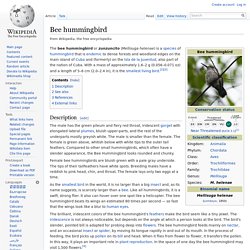
With a mass of approximately 1.6–2 g (0.056–0.071 oz) and a length of 5–6 cm (2.0–2.4 in), it is the smallest living bird.[2][3] Description[edit] Female bee hummingbirds are bluish green with a pale gray underside. The tips of their tailfeathers have white spots. Breeding males have a reddish to pink head, chin, and throat. As the smallest bird in the world, it is no larger than a big insect and, as its name suggests, is scarcely larger than a bee. The brilliant, iridescent colors of the bee hummingbird's feathers make the bird seem like a tiny jewel. Using bits of cobwebs, bark, and lichen, the female bee hummingbird builds a cup-shaped nest that is only about 2.5 cm (1 inch) in diameter. See also[edit] Hummingbird moth. Bird of prey. Birds of prey, also known as raptors, hunt and feed on other animals.
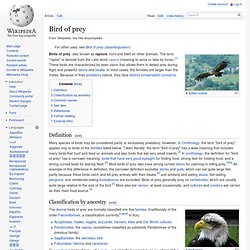
The term "raptor" is derived from the Latin word rapere (meaning to seize or take by force).[1] These birds are characterized by keen vision that allows them to detect prey during flight and powerful talons and beaks. In most cases, the females are larger than the males. Because of their predatory nature, they face distinct conservation concerns. Definition[edit] Classification by ancestry[edit] Strigidae: (typical owls)Tytonidae: (barn and bay owls).
The observation that otherwise unrelated bird groups may perform similar ecological roles and bear striking morphological similarities to one another is explained by the concept of convergent evolution. Common names[edit] Eagle. Eagle is a common name for some members of the bird family Accipitridae; it belongs to several genera that are not necessarily closely related to each other.

Most of the sixty species of eagles are from Eurasia and Africa.[1] Outside this area, just eleven species can be found – two species (the Bald Eagle and Golden Eagle) in the United States and Canada, nine species in Central America and South America, and three species in Australia. Description Eagles are large, powerfully built birds of prey, with a heavy head and beak. Even the smallest eagles, like the Booted Eagle (Aquila pennata) (which is comparable in size to a Common Buzzard (Buteo buteo) or Red-tailed Hawk (B. jamaicensis)), have relatively longer and more evenly broad wings, and more direct, faster flight – despite the reduced size of aerodynamic feathers. Most eagles are larger than any other raptors apart from some vultures. Eagles normally build their nests, called eyries, in tall trees or on high cliffs.